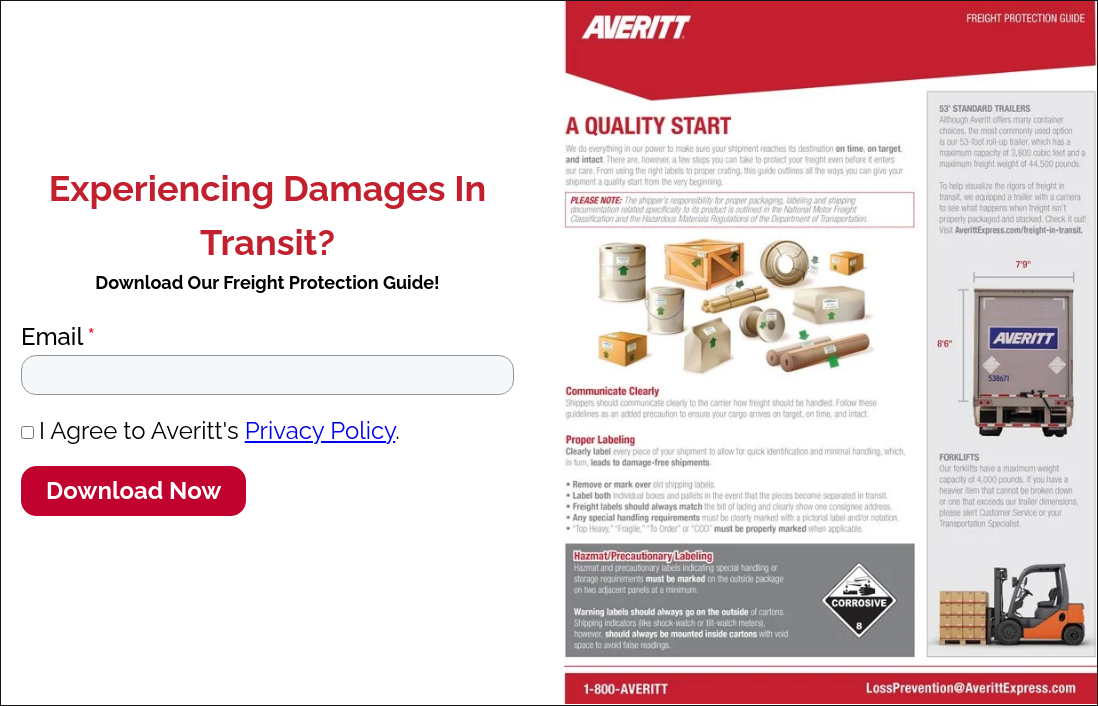Less Than Truckload (LTL) shipping presents several unique challenges in the world of freight and logistics. Chief among these is LTL rate management – due largely to the sheer number of factors that influence LTL shipping rates.
First, there's the very nature of LTL shipping itself. The process of freight consolidation, where multiple customers' shipments are placed into a single trailer, introduces variability in LTL rate management right from the start. From there, factors such as distance, accessorial charges, LTL freight classes, carrier-specific tariffs, and fuel surcharges add to the complexity.
The key to mastering this challenge lies in leveraging technology – specifically, a Transportation Management System (TMS). Modern TMS platforms bring automation, seamless integration with carrier systems, and powerful analytics capabilities to the shipping process. Recent technological evolutions have streamlined the entire LTL rate management process even further – introducing dynamic freight pricing methods that respond in real-time to market conditions.
By optimizing how rates are managed, these TMS solutions pave the way for a more adaptable, responsive approach to freight pricing and set a new standard in LTL shipping.

The Role of TMS in LTL Rate Management
TMS platforms provide a host of functionalities designed to optimize the shipping process. This includes enabling real-time rate comparisons, which allow users to quickly evaluate different carrier rates to find the most cost-effective options. This capability is crucial in today’s fast-paced logistics environment, where timely decisions can significantly impact the bottom line.
Also, a TMS can seamlessly integrate with carrier systems, facilitating direct communication and data exchange. This integration ensures that shippers have access to the latest rates and service offerings, which improves the accuracy of shipping estimates and reduces the risk of errors. TMS platforms also provide powerful analytics tools, which enable businesses to analyze their shipping patterns and expenses, identify opportunities for savings, and make data-driven decisions to optimize their logistics operations.
A prime example of a TMS that showcases these features, including LTL rate management and reporting, is Averitt Connect. This platform offers a user-friendly online interface where shippers can directly shop for unbiased LTL rates from Averitt and other carriers, book and track shipments, and access a range of other logistics management tools – all without the need for intermediaries.
Watch the short video below to learn how Averitt Connect can save you time and money with your LTL rate management and shipping needs!
struggling with multiple carriers rate quotes and tracking sites now it's never been easier to take control of your ltl and volume shipping needs thanks to averitt connect averitt connect is an online transportation management solution that lets you control your shipping process directly with your carriers it gives you quick access to multiple rates from ltl carriers throughout the us then lets you book and track your shipments through one easy to use online portal dramatically streamlining your freight process no more tracking multiple logins and passwords keeping endless quotes on hand just in case or having to manually manage exceptions and most importantly no more middleman is just you and your carriers with averitt connect carriers provide their own independent rates without seeing what others have offered this ensures you're getting the kind of unbiased information that lets you make the best decision for your business averitt connect is a true direct to carrier tms that will transform your freight process with tools that let you quote coordinate and track all your shipments with all your carriers all on one system and it's available for free from averitt express so visit averittconnect.com today and get started and discover just how simple shipping can be
Thanks to its carrier direct system, Averitt Connect ensures users benefit from a highly competitive, unbiased marketplace for LTL rates. Also, by automating the freight bill auditing process, Averitt Connect helps save time and reduce the potential for billing discrepancies – making it a valuable tool for businesses looking to streamline their LTL shipping processes.
Averitt Connect Customer Case Study: All South FlooringAll South Flooring, a wholesale floor covering distributor, has seen significant operational benefits from implementing Averitt Connect. The platform streamlined their quoting and shipment execution processes by aggregating rate quotes and shipment management in one place. This integration not only improved internal workflows but also enhanced communication and transparency with customers, providing automated tracking updates. Watch the video below to learn more about how Averitt Connect helps to drive efficiency and customer satisfaction within All South Flooring's operations. And all South Forum were a wholesale floor covering distributor. He does a young business that you grow through multiple phases and a piece of that is trying to find different technologies that increase your efficiency and allow you to operate at a higher level. When we got started, we used different carriers, and we were logging into different websites, manually and out bill lading, trying to quote, waiting on emails back. And as we grew and the volume, followed suit, we started to look for how can we be more efficient in a work process. So I had the opportunity to have a meeting with, Greg to discuss LPL shipments. And during the meeting, introduced And I explained to him the capabilities where he can quote coordinate and track all the shipments for all his carriers, all on one platform. When Maritza approached us for for Avert Connect, once we were finally able to sit down and see a demo and see the practical application of the software, It was a no brainer for us. It made just the ease of quoting shipments, generating bill lading, the paper, and work flow that we have internally. It made all of it much smoother. When it comes to Abraham Connect, all South flooring has benefited in several ways. Initially, it was just get our rake boats all in one place execute our shipments all in one place. As they became more comfortable with the system, they realized there was more opportunity expand into areas such as integration that would simplify their process greatly. We're even going to take it a step further in the next year, and our next phase of that is actually integrating, the Avert Connect with R ERP system. So they'll actually give us real time rates within our ERP system, generate the bill lading and and take another step out of the process. With integration, orders come in automatically. There's no manual entry. So, it's been great so far. The transition was as painless as it can be, and, we're looking forward taking kind of the next step in integrating that even more so into our order process. So when you think about efficiency relative to Award Connect, let's just say you're using three carriers. The time it takes to look up those three carriers enter the shipment information three times, get the results, compile that somewhere, make a decision to go back, execute, When all that can be done in one platform at Avar Connect, you get the three answers that you were looking for, you get the ability to execute, Then you get all the after shipment benefits of track, trace, document retrieval. You've got the ability to send information back to the host system. You can audit All these things are available. And it's really increased the transparency and the communication that we have not only internally between the warehouse and over entry. Also our customers, they get automated emails with tracking information. Let's face it. We're all competing with Amazon. Right? They wanna know when their water's placed, when it's gonna be delivered, when it's shipped, and they expect it to happen within two days. And, honestly, Ara Connect allows us to meet those standards with our customers and, it's it's a huge value add for us.
|
Understanding LTL Rate Challenges
One of the primary challenges in LTL rate management has been the reliance on static pricing models and the inherent lack of flexibility in traditional systems. These static models can't accurately reflect the ever-changing dynamics of freight demand and transportation costs – like changes in fuel prices, variations in demand, and shifts in carrier capacity. As a result, shippers encounter inefficiencies that complicate the shipping process and result in missed opportunities for reducing expenses.
And there are other challenges as well. For instance, traditional LTL rate management involves navigating a labyrinth of tariffs, each with its own set of rules, accessorial charges, and contractual agreements. These charges for additional services – such as residential delivery, liftgate service, or inside pickup and delivery – can significantly affect the total cost of shipping. Predicting them in advance, however, can pose a challenge.
This traditional approach presents a significant hurdle for shippers in that it demands a high level of expertise and constant vigilance to navigate effectively. This underscores the need for more dynamic and adaptable solutions in the freight and logistics industry.

Introduction to Dynamic Freight Pricing
Dynamic freight pricing represents a game-changing development in the logistics industry, revolutionizing how LTL freight rates are calculated and applied. Instead of rigid static pricing models, dynamic pricing introduces a more fluid approach that adjusts rates in real-time – to reflect current market conditions, fluctuating demand, and more. This strategy ensures that the rates more accurately mirror the actual shipping costs, allowing shippers to take advantage of more favorable rates as they emerge.
The essence of dynamic freight pricing lies in its ability to adapt swiftly to the changing landscape of the freight market. By continuously analyzing factors like fuel costs, seasonal demand shifts, and carrier capacity, dynamic freight pricing offers shippers access to competitive rates. It also enhances their ability to plan and manage shipping costs with greater precision and flexibility.
Systems like Averitt ExactRate are leading this shift towards more adaptive general freight shipping and LTL rate management. Developed in collaboration with SMC3, a leader in LTL technology solutions, ExactRate empowers shippers with precise, market-responsive rates, enhancing decision-making and cost-efficiency.
By leveraging real-time data and sophisticated algorithms, ExactRate delivers a dynamic pricing solution specifically designed to meet the challenges of LTL rate management. The result is a more strategic, informed approach to LTL shipping that optimizes cost-efficiency and improves decision-making processes.
By embracing dynamic freight pricing, shippers can navigate the complexities of LTL shipping with greater ease and confidence, securing the best possible rates and enhancing their overall logistics strategy. This move towards more transparent, market-aligned pricing models marks a significant step forward in the evolution of freight logistics, offering a path to more sustainable, efficient, and adaptable shipping practices.
Embracing Advanced TMS and Dynamic Pricing for LTL
The adoption of cutting-edge TMS platforms and dynamic pricing models – as exemplified by solutions like Averitt Connect and Averitt ExactRate – marks a significant advancement in the management of LTL rates. These technologies do more than streamline the complexities of LTL shipping – they unlock new levels of flexibility, efficiency, and strategic insight. By utilizing real-time data and analytics alongside pricing that adapts to market conditions, shippers are more empowered and agile than ever.
As the logistics industry continues to evolve, embracing these modern solutions will be key to staying competitive and meeting the demands of a dynamic market. For those looking to enhance their logistics and shipping strategies, exploring technologies like Averitt Connect and ExactRate is an excellent starting point.
Want to Learn More about Averitt Connect or Averitt ExactRate? Fill Out The Form Below!







.jpg)



